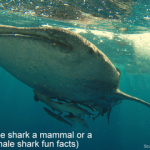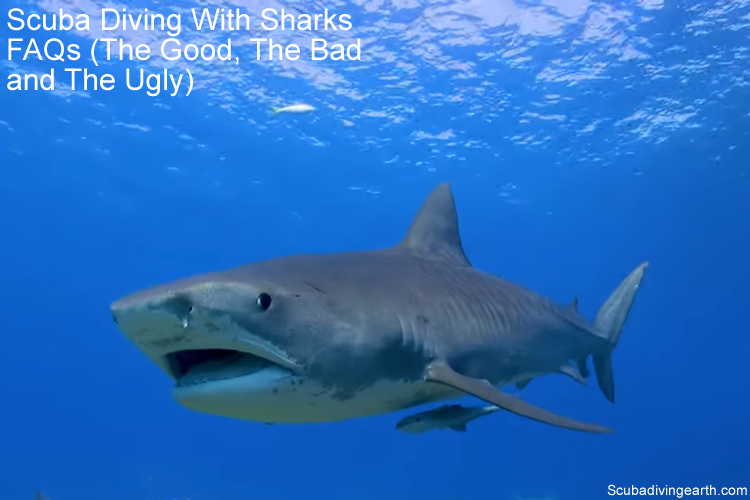
Scuba diving with sharks key questions and answers – The truth unveiled about sharks and shark behaviour
I have been scuba diving with sharks for years. But I know some divers are scared to dive with sharks. Plus some have not yet dived with sharks. In this article I will look at the FAQs on scuba diving with sharks. Together with the Good, the Bad and the Ugly about sharks.
So let’s take a look at some of the questions that are asked by scuba divers and non-divers about scuba diving with sharks.
Scuba diving with sharks is exhilarating and sometimes involves heart in the mouth moments. Scuba diving with sharks isn’t always about cage diving, but about getting up close and person with these top predators of the deep. Not close enough to touch, but near enough to see their dark cold eyes!
To dive with great white sharks, you may want to consider Mexico’s Guadalupe Island and dive this on a scuba diving liveaboard. You can check the latest and best deals on Mexico liveaboards using the following window:
What makes a shark a shark?
Sharks are cartilaginous fish. This means their skeleton is made from the flexible substance cartilage. Cartilaginous fish not only include sharks, but also include rays, skates and sawfish too.
Sharks are a member of sub class of cartilaginous fish, which are elasmobranchii fish. An Elasmobranchii fish means they have between 5-7 gill clefts, a rigid dorsal fin and they have small placoid scales of their skin.
These small scales that sharks have on their skin makes it feel rough and almost like sandpaper.
The pelvic fins in male sharks have been modified through evolution to create claspers. These claspers are used to transfer sperm to the female shark.
What is also peculiar to sharks is they don’t have swim bladders like other fish species for buoyancy. But instead sharks maintain their buoyancy with large livers rich in oil.
Although the sand tiger shark has a unique solution to the buoyancy problem for sharks. Sand tiger sharks gulp air into their stomachs for them to maintain neutral buoyancy.
But also, most shark species have to swim constantly in order to flush oxygenated water over their gills. This is unlike bony fish which don’t need to swim constantly. See below for more details on this question about sharks.

What do you do if you see a shark while scuba diving?
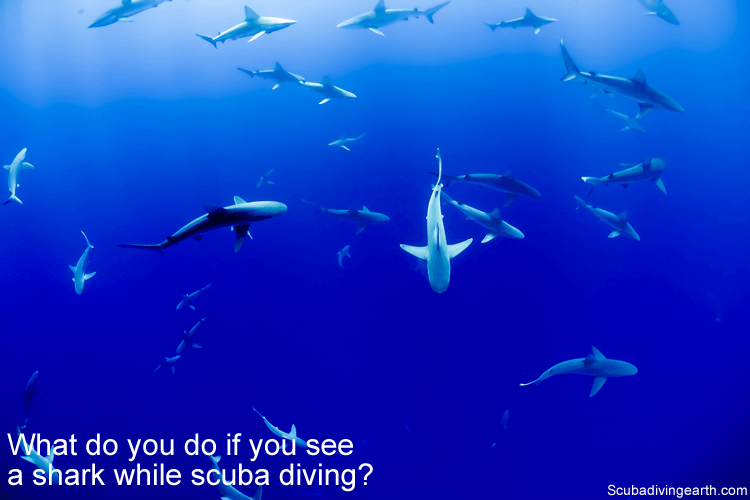
My first reaction to this question ‘What do you do if you see a shark while scuba diving? is to say get excited and enjoy!
The answer to this shark question depends on where you are on your dive profile. If you’re descending, or ascending, or mid-dive, depends on what you may do if you see a shark.
If you spot sharks during your ascent or descent, you are better off getting to the surface as promptly as you can or descending to the bottom as fast as you can.
But you must always keep in mind safety with your ascents and descents. Remembering if you ascend too quickly, you could have problems with decompression sickness. Plus remembering your safety stop at 5-6 metres (16-20 feet) for 3 minutes.
Essentially, you want to avoid the water column and being on the surface, as this is where the majority of sharks hunt.
Are sharks afraid of humans and are sharks really that dangerous?
What many don’t understand is that sharks are often more afraid of humans than we are of them.
Humans are not on the lunch time menu for sharks. We are not their normal prey. In fact sharks have every reason to be afraid of humans, as we slaughter some 100 million sharks every year!
Sharks are killed for shark fin soup in their thousands. This is criminal and in many cases barbaric. See further in the article when I talk about the slaughter of sharks for their fins.
If you stop to think about this for a moment humans are not naturally underwater creatures. Plus when you add to this scuba gear which is actually quite noisy underwater. Most sharks tend to be afraid of the bubbles that are generated from a scuba aqualung.
Sharks are predators that cannot afford injury
Sharks are predators and need to be in top physical fitness without injury. When a shark first sees a scuba diver, they don’t know what they are. So most are cautious in this situation.
In nature sharks are afraid of sustaining an injury, which would prevent them from hunting.
But what has made sharks more bold around scuba divers, is feeding and baiting. Over time sharks associate the arrival of the dive boat and the splashing of divers in the water with food. Sharks smell the blood and oils that escape the food container which is taken by the dive guide to feed them.
This is what happens at Tiger Beach Bahamas for example. This also happens at some of the other places known for tiger shark diving, which attracts other sharks like bull sharks, reef sharks, hammerheads and lemons sharks.
Is scuba diving safe from sharks?
The majority of scuba divers who’ve experienced sharks on a dive will agree that it’s a privilege to see sharks on a dive. The risk of you being harmed or bothered by a shark when scuba diving is almost not worth worrying about.
The risks of scuba divers being attacked is negligible.
Having said that, to be safe from sharks you should always treat them with respect. There are far more provoked shark attacks than there are unprovoked shark attacks. Provoked attacks include spear fisherman.
When you spear a fish the injured fish sends out a signal that most sharks find almost irresistible. Add the blood loss to the frenzied movement of an injured fish on the end of a spear you are asking for trouble.
Watch the video below where a bull shark goes to attack a spear fisherman. Whilst this is not a nice video to watch, as the shark gets seriously injured, it proves the point.
Why do sharks not attack divers?
Sharks have evolved over millions of years as apex predators. During this evolutionary period they have adapted to the prey they hunt.
Depending on the species of shark, this can range from other fish, to sea turtles, to mammals like seals and sea lions.
Why do sharks not attack divers?
What is not included in their evolutionary diet is humans. But more importantly, scuba divers with equipment and wet suits etc. That’s not to say sharks don’t attack humans, because they do, but it’s mostly due to mistaken identity.
This happens mostly with surfers, as they are in the feeding zone for certain sharks. From beneath the surface a surfer can look like a seal or a turtle. Plus a surfer is splashing to paddle their board, which in itself attracts sharks looking for an easy meal.
To put this into perspective, the chance of being attacked by a shark in the US is 1 in 11.5 million and the chances of being killed is less that 1 in 264.1 million.
That means the risk of getting killed by a shark is so rare, you are almost more likely to win the lottery.
For example, the odds in America of winning the jackpot is 1 in 302 million! See below on the odds of being killed by other accidents.
Which sharks are dangerous to divers?
Having said that sharks tend not to attack or bother scuba divers. There have been incidents of attacks. However, most shark attacks are on water-users in general and rarely on scuba divers themselves.
There are over 1,000 species of sharks and rays living in our oceans, with around 400 species of sharks. But also did you know that there are around 134 shark species that live on the Great Barrier Reef.
What is the most dangerous shark to man?
Of the attacks by sharks on water users as a whole, there are only a handful of sharks that can be particularly dangerous when encountered in the wrong situation.
Bull sharks (Carcharhinus Leucas) are the most dangerous to man and account for most of the unprovoked attacks. Bull sharks account for more deaths to humans than any other shark, which includes Great White Sharks. But these attacks are mostly on bathers in the shallows around coastal waters and in estuaries.
Other shark species responsible for unprovoked attacks on humans include the great white shark (Carcharodon carcharias) and the tiger shark (Galeocerdo cuvier).
But let’s take a look at the individual sharks that people ask questions about.
More Reading: What are three interesting facts about the great white shark? (Plus 50 cool facts)
Are tiger sharks dangerous to divers?
Tiger sharks aren’t dangerous to divers so long as they’re not provoked. Having said that, tiger sharks have a reputation for being dangerous and are among the top three sharks responsible for shark attacks, alongside bull sharks and great white sharks. Known as dustbins of the oceans, tiger sharks eat almost anything.
The tiger shark is included with the Bull and the Great White shark as the only three sharks that are responsible for two-digit numbers of fatal unprovoked attacks on humans.
But before you begin to worry as a scuba diver or a potential scuba diving student, these attacks are on water users as a whole.
The number of fatalities on scuba divers is extremely low.
But when an attack happens on a scuba diver, there is usually a reason for it. For example, spearfishing is one good example where a mistaken attack may occur.
But also by knowing where sharks are in the water, which is especially true when scuba diving on a shark bating dive site, will help to prevent an accidental shark attack.
Why do tiger sharks attack humans?
Tiger sharks attack humans when they mistake surfer silhouettes as turtles from below. Humans aren’t on the menu for tiger sharks and usually don’t continue with their attack once they realise their mistake. But unfortunately this may be too late and no consolation to the victim who may bleed to death from the bite.
Attacks not only happen to surfers, but also involve spear fishing snorkelers, as the sharks are attacked to the injured fish. Other water users are also attacked, but generally scuba divers aren’t attacked.
But looking at tiger sharks in isolation, they are known for their indiscriminate eating habits and have voracious appetites.
Tiger sharks are predatory creatures and have probably one of the widest variety of diets of all shark species. But also tiger sharks often visit shallow reefs, harbors, and canals, which creates the potential for an encounter with humans.
Due to the tiger shark’s seemingly indiscriminate appetite, and because of their curious and inquisitive nature, they can become aggressive towards humans. Because of this, they must be treated with extreme caution.
One of the problems with sharks is that they use their mouths to investigate. This is true of tiger sharks and is not something you want to have happen.
An investigatory bite or taste testing by a tiger could cause serious or fatal damage.
You’ll see how bold the tiger sharks are in this video of Tiger Beach Bahamas.
Is the bull shark the most dangerous shark?
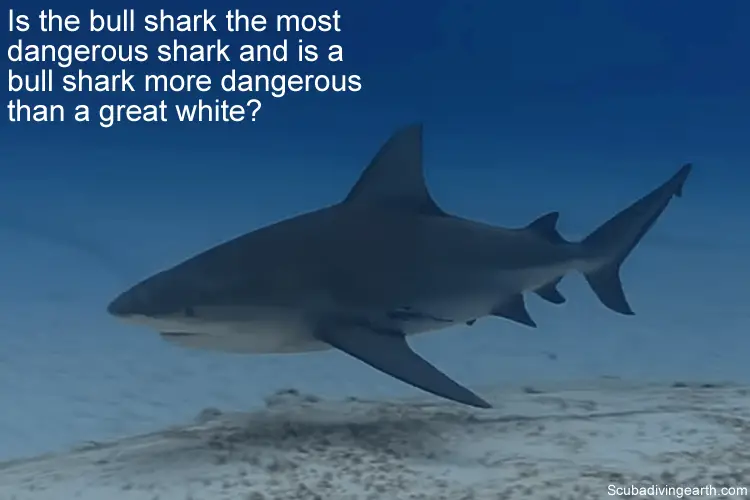
The bull shark is the most dangerous shark in our oceans. They are highly aggressive and have the highest level of testosterone of all living animals. Add to this fact that they live in murky shallow waters including rivers and estuaries they often mistakenly attack people.
Bull sharks are one of the only sharks that can cross over between salt water and fresh water living.
Bull sharks are sometimes found hundreds of miles upstream in rivers. The problem here is that rivers tend to be murky and dark. Bull sharks can then mistake a human for its prey. Or they may simply be going in for that exploratory bite.
Bull sharks are territorial sharks and can have a low tolerance for provocation. This means that as with all sharks you should respect bull sharks when you encounter them when scuba diving.
Is a bull shark more dangerous than a great white?
Arguably yes bull sharks are more dangerous than great white sharks to water-users as a whole. But not necessarily when it comes to scuba divers. This is because of the habitats in which they live.
Bull sharks can appear in the most unlikely of places. They can survive in freshwater, which is why unsuspecting water users get attacked along rivers.
But it’s extremely rare for bull sharks to attack scuba divers. I would say that I’d prefer to scuba dive outside of a cage with bull sharks than I would with great white sharks. But I’m happy to be proved wrong on this point.
I’d happily scuba dive with great white sharks not in a cage, but I know my heart would be racing!
I recall a conversation with a dive guide I used in South Africa who invited me to spend a week with him.
My dive guide guaranteed I’d have sightings of great white sharks. But he defied me to not feel fearful when the shadow of the shark appears. He explained how even now every time he sees a great white shark, his heart’s in his mouth.
He would quite often encounter great whites as a commercial diver helping local fishermen and other ships clearing propellers and such like.
Can a bull shark kill you?
Bull sharks can kill you and are known to be the most dangerous shark in our oceans. This is because they are found in such shallow waters where people don’t expect sharks to live. These bull sharks are not usually seen until it’s too late as the waters tend to be murky.
Of all the sharks in the ocean that can kill a human, bull sharks are one of those sharks that could. According to the International Shark Attack File (ISAF), bull sharks are historically responsible for at least 100 unprovoked attacks on humans around the world each year.
Of these attacks, 27 of them have been fatal attacks. But it is likely that bull sharks could be responsible for many more that go unrecorded in places like Africa and India. See the National Geographic video below.
A swimmer in the waves off a beach is attacked by a shark — it’s a frightening scenario. But in India, the victims aren’t in the ocean … they’re waist-deep in a river.
How dangerous are nurse sharks?
Nurse sharks are not seen as dangerous to humans. Nurse sharks are one of the most docile of sharks and live on the bottom of our oceans. But having said that they still have a strong bite grip so you are best not to provoke them.
These slow-moving creatures are mostly harmless to humans and divers. But they can get aggressive if provoked. Nurse sharks can grow to over 4 metres (14 feet) long and should be observed and left alone.
Accidents happen when scuba divers get too close to a nurse shark. Or when they mistake their docile nature as an invite to touch them.
Some divers can get away with this, but other times these creatures can turn on a diver who over-steps the mark. Never corner a nurse shark, as these sharks have very strong jaws which are filled with thousands of tiny serrated teeth.
Can a nurse shark kill you?
It’s unlikely that a nurse shark could kill a human and there have been no fatalities from all nurse shark attacks. Surprisingly, nurse sharks are ranked fourth in documented shark bites on humans, which is because divers mistake their docile nature as an invite to touch, but it’s this touching that provokes an attack.
Scuba divers think they can touch or get closer to nurse sharks than they can with other sharks they encounter. This is when a bite can happen.
But whether or not a nurse shark can kill you is up for debate. I’m sure it could if it wanted to, but mostly when bites happen they will bite and retreat quite quickly. Any bite from a nurse shark will be as a warning.
However, where a death may occur is if the bite is serious and the diver then suffers significant blood loss. The another scenarios might be the consequential impact of a shark bite. This could include a fast ascent which could lead to other diver related problems, like the bends, which can be fatal.
Are Hammerheads dangerous to humans and do hammerhead sharks kill humans?
I love to see hammerhead sharks when I’m scuba diving. These strange looking creatures fascinate me. Why the hammered head, which is called the “cephalofoil“? Where did this come from in evolutionary terms?
But are hammerheads dangerous to humans. But more importantly for divers, do they pose a threat to scuba divers.
Hammerheads are not dangerous to humans and account for very few attacks. The most common is the scalloped hammerhead, which is harmless and can be found schooling in places like the Galapagos Islands and is the smaller of the species. The larger great hammerhead is mostly solitary, but is still not a man eater.
Most hammerhead sharks are smaller than say tiger sharks or bull sharks, unless you are talking about the great hammerhead shark.
The great hammerhead shark can grow to over 6 metres (20 feet) long and unlike the scalloped hammerhead which is known for schooling in large numbers, the great hammerhead tends to be a solitary shark. Although the great hammerhead could be potentially dangerous to divers, they rarely attacks humans.
Having said this, they do sometimes behave inquisitively toward divers. They should therefore be treated with respect, as with all shark species.
But in looking at attacks by hammerheads, there have been just 17 documented human attacks by hammerhead sharks with no fatalities.
Unfortunately for these beautiful creatures and due to the size of their fins, they are heavily fished for their fins for soup.

Do sand tiger sharks or grey nurse sharks attack humans?
The sand tiger shark (Carcharias taurus), is not related to the tiger shark, but it’s name comes from where it lives.
Sand tiger sharks (also known as grey nurse sharks) don’t attack humans, despite their vicious looking and protruding teeth. Sand tiger sharks are very docile sharks but are of no threat to scuba divers.
They are however a close relative of the great white shark. Other names for the sand tiger include the ragged-tooth shark or ‘raggies‘ for short or the grey nurse shark. Which is what they tend to get called in Australia.
Rather than the tell-tale strips of the tiger shark, raggies have spots on the flanks instead. Sand tiger sharks are also known for having babies that are active embryonic cannibals. Embryonic cannibalism is where the first baby to hatch inside the female sand tiger, will eat all the other eggs.
Sand tigers live in subtropical and temperate waters worldwide around the continental shelf and sandy shorelines and are an endangered species.
They are found off the coasts of Australia, South Africa, the Mediterranean and the east coasts of North and South America.
If you look at the above image of the sand tiger shark they look menacing and dangerous. But these sharks are mostly docile and don’t attack humans. The mouth of a sand tiger is unlikely to be large enough to cause a human fatality too.
An interesting video below created by Jonathan Bird’s Blue World about sand tiger sharks of North Carolina.
Jonathan heads to North Carolina to explore the offshore shipwrecks of the “Graveyard of the Atlantic” which have become home to Sand Tiger sharks. The sharks are unwitting bodyguards to small fish seeking protection from predators and have developed a clever way to hide from the fish and to hover with perfect buoyancy control.
Are mako sharks dangerous?
Mako sharks tend to live away from the shoreline and in open seas. The shortfin mako shark is also known as the blue pointer or bonito shark.
Mako sharks are not dangerous to humans as they live in the deep oceans and rarely come into contact with people. As for most sharks, humans are not considered to be their prey, but if provoked they could certainly cause a significant injury.
What the shortfin mako shark is known for is being the fastest-swimming shark. But not as a man eater or a shark that attacks humans. This shark is capable of bursts of speed of up to 68 kilometres/hour (42 mph).
The only time that an attack might happen between a mako shark and a human is where the shark has been provoked or harassed in some way.
This is only likely to happen if the shark has been caught on a fishing line, but very unlikely from an encounter with a scuba diver.
Do reef sharks bite?
Reef sharks including grey, whitetip and blacktip sharks tend to be mostly timid sharks.
Reef sharks are not considered to be dangerous to humans and are unlikely to bite unless provoked. They are often encountered by divers in large numbers in places like the Bahamas and Antigua without incident. There have been attacks by reef sharks on people, but none of these have been on scuba divers.
So on the whole reef sharks tend not to pose a threat to humans and rarely if ever to scuba divers, but let’s take a look at blacktip and whitetip shark attacks on humans.
Do blacktip and whitetip sharks attack humans?
Both blacktip sharks and whitetip sharks are curious around scuba divers, but generally they tend to keep a safe distance from them.
Neither blacktip nor whitetip reef sharks are regarded as dangerous towards humans. But as with all sharks in their own environment, they demand respect and in a ‘baited’ dive situation they can be fast swimmers and care needs to be taken at all times.
Do lemon sharks attack humans?
Lemon sharks have been recorded as attacking humans on just 10 occasions in an unprovoked situation. Non of these unprovoked attacks were fatal.
The conclusion is therefore that whilst there have been lemon shark attacks on humans, they are extremely rare and are unlikely to be on scuba divers.
Are blue sharks dangerous?
Blue shark attacks have led to four fatalities since records began from 1580. So it’s safe to assume that these sharks are very unlikely to attack scuba divers.
Blue sharks are similar to mako sharks as they inhabit open water away from the shoreline in deeper waters. This means they are rarely in contact with scuba divers in any case.
There’s more chance of a fisherman getting bitten by a blue shark, as these sharks are fished as game fish due to their speed.
How do you survive a shark attack?
I want to begin the question by saying that it’s unlikely you will have to defend yourself against a shark attack. But I wanted to answer a question that’s asked by scuba divers about surviving a shark attack.
In the unlikely event you find yourself in the middle of a shark attack, what should you do?
- Sharks can sense fear so don’t panic.
- Put your back to a wreck or reef so it can’t get behind you.
- Maintain eye contact as the shark swims around you.
- Slowly back away, but don’t bolt to the surface.
- Make yourself as big as you can to gain respect.
- Punch or kick the shark on its nose or in its eyes.
First and foremost is to not panic if you’re either surrounded by sharks or sharks are getting close to you. Sharks sense fear and this can encourage aggressive behaviour.
Sharks are curious by nature, but on the whole sharks stay away from scuba divers. But when they do choose to get closer, keep them in sight and stay relaxed.
Always maintain eye contact with sharks
Always maintain eye contact with the shark and if you are in a group of divers, look out for your buddy divers too. If you see a shark coming up behind one of your buddies, let them know by using the shark signal.
The scuba diver’s shark signal is done by putting your hand on your head as if to demonstrate the shark’s dorsal fin.
If the shark gets too close, push it away on its nose and if necessary use enough force to show it who’s boss. Stay big and look dominant, as you want the shark to feel you are a threat to it, rather than the other way around.
If you can slowly back away from the situation and avoid threatening or further provoking the shark, this will help.
But make sure you always keep an eye on your air. Plus when you return to the surface, do so at the appropriate ascent rate.
How do you stay safe around sharks when scuba diving?
You should already be safe around sharks when you dive, but for the avoidance of doubt, it’s important to run through the safety tips for scuba diving with sharks.
Therefore to reduce what is already a very small risk of being attacked by sharks as a scuba diver, let’s take a look at some tips to staying safe.
How to stay safe around sharks
- Do not provoke sharks by touching them. Look but don’t touch.
- Be aware that if you spearfish you are increasing the risk of an attack by sharks. This is especially true if you’re spearfishing in waters with tiger sharks, bull sharks and great white sharks in the vicinity.
- Be careful when spearing lionfish in and around the Caribbean. There’s a culling going on with these non-native fish that have appeared in the Caribbean Sea. I was on one such dive in Antigua and we had a very interested reef shark circling us. This is when mistakes can happen and a scuba diver could be mistakenly bitten. This type of shark attack would be regarded as a provoked shark attack.
- Always scuba dive in buddy pairs as sharks are more likely to pick on individuals. You should be diving as a buddy pairs in any event, which is safe diving practice.
- Spend as little time in the water column as you can, which is the descent and ascent zone. But being mindful of the correct descent and ascent rates and keeping in mind your decompression times.
- Be aware of diving when you have any open wounds. Sharks are very sensitive to the smell of blood in the water.
- Some would argue you shouldn’t wear shiny jewellery, as this can mimic fish scales and trigger an attack. However this is extremely unlikely on scuba divers, as much of diving equipment has reflective stainless steel and this never seems to cause problems.
- Be careful scuba diving in low visibility waters where bull sharks are known to live. Bull sharks hunt in these waters, especially around rivers, estuaries and near sewage outlets.
- Relax and enjoy the experience. Sharks are amazing creatures and great to observe and enjoy.
More Reading: How do I get a dive buddy? (5 easy ways to find a dive buddy)
Is it illegal to chum the water for sharks?
Chumming or shark baiting is commonly done in places like South Africa to lure great white sharks. This is done to attract sharks to make sure divers are not disappointed.
Chumming the water for sharks is also done by researchers too. This is to lure sharks in for research purposes.
In most countries it is legal to chum the water for sharks, but there are certain regulations that control its use in a number of places.
What happens if a shark stops swimming?
Unlike non-cartilaginous or bony fish, sharks must swim constantly in order to keep water flowing over their gills. Bony fish use the pumping action of their mouths and pharynx to pass oxygenated water over their gills.
There are exceptions to this, for example sand tiger sharks or grey nurse sharks are able to hover in the water. Also, nurse sharks are able to lie on the bottom for long periods too. These sharks are able to pump water over their gills in the same way that bony fish do or with nurse sharks that have spiracles to move the water over their gills in the same way.
However, sharks like the great white, tiger sharks, hammerhead sharks, bull sharks and reef sharks must all swim constantly to stay alive.
Do sharks sleep at all?
Sharks that have to swim constantly to stay alive never sleep. In fact many species of shark are awake during the day patrolling their habitat. Only to truly come to life at night to hunt.
This is certainly true of grey reef, white tip and blacktip sharks. These sharks terrorise the reef fish at night that are sleeping. Prey fish that are hiding in the holes and crevices of the coral reefs are brought out into the open and eaten by these reef sharks.
Nurse sharks are able to rest for long periods of time, as these sharks are able to pump water over their gills. But whether they actually sleep is another question.
Do sharks eat humans?
As already mentioned above, humans are not naturally on the sharks dinner menu. So normally sharks do not eat humans.
Since the film Jaws, sharks have been given an even more scary reputation than they deserve. Yes sharks are predators, and yes they do attack other animals, but sharks rarely attack humans. In fact if they do attack a human, it’s usually as a result of mistaken identity or it’s a provoked attack.
Sharks generally feed on fish, except for tiger sharks which eat almost anything and one of their favourites being turtles. But also great white sharks eat seals, which is necessary for them to keep their body temperatures higher than the surrounding water.
Great white sharks burn more calories than any other shark, and as such need to feast on blubber rich seals to feed this high calorie burn rate.
Are sharks afraid of magnets?
One way to repel sharks is to use shark repelling magnets. These magnets work by affecting the sharks sensitivity to electrical stimulation.
Sharks have receptors in their noses that can detect the smallest of electrical impulses. These are ampullae or Lorenzini and are used to track down injured or struggling fish. Sharks use this electrical sensitivity to home-in on their prey.
But through the use of shark repellent magnets, the sharks ampullae can be used against them. Whilst sharks are not afraid of magnets, they are affected by them and would generally stay away from the magnetic impulses these generate.
This electrosense that’s found in sharks is not found in bony fish. This means that these magnetic shark repellents target sharks and rays only.
How many humans are killed by sharks each year?
When you look at the number of humans that are killed each year by sharks in comparison to the number of water users, this is a very small number.
When I say water users, I include in this beach bathers, swimmers, snorkelers, surfers and scuba divers.
Since proper records have been kept of shark attacks and fatalities from 1958, there have been a total of 439 fatal shark attacks. That’s a total of around seven deaths per year.
But of this seven shark related human deaths per year, a very small percentage of these would be scuba divers.
Now I’ve established how many humans are killed each year by sharks, let’s take a look at a few comparisons of how many humans are killed through other events.
How many surfers die from shark attack?
Using the same shark attack statistics as above, of all the shark attacks in 2016 58% were attacks on surfers.
The reason why surfers are a higher target than scuba divers is surfers are in the attack zone for sharks. Not only that, surfers are more vulnerable on the surface and they are splashing like a wounded animal would.
It’s this splashing that attracts the sharks and then many times the final attack is through mistaken identity. From underneath the water, a surfer will look a bit like a seal or a turtle to a hungry shark.
How many people are killed by mosquitoes each year?
According to the World Health Organization, a staggering 725,000 people are killed every year by a mosquito-borne disease.
This statistic is almost too difficult to comprehend. As mosquitoes are such small creatures, the number of deaths from them seems almost impossible.
You are therefore more likely to be killed by a mosquito at your resort between dives than you are on the dive itself. This of course assumes you’re diving in a country that has a malaria problem. Plus you haven’t taken the correct malarial preventative medicine.
How many people are killed by dogs each year?
A staggering 5 million people are attacked by dogs each year. In the US alone, between 30 and 50 people die each year from dog bites.
Whereas the number of shark attacks each year is either constant or lower each year, the number of deaths from dog attacks on humans appears to be increasing year on year.
In the US you are more likely to be killed by a dog than by lightning.
How many people are killed by lightning per year?
Leading on from the high statistics of deaths from dog bites over lighting strikes, how many are killed by lightning strikes?
Over the last 20 years, the United States averaged 51 annual lightning strike that resulted in a single fatality.
How many people die from coconuts?
It is estimated that around 150 people die from coconuts falling on their heads each year. This is way more than the number of fatalities from shark attacks.
How many people are killed in the US from Christmas trees and decorations
Christmas trees can cause home fires, and as a result there are a few fatalities each year. There appears to be some quite high numbers of people killed in the US from Christmas trees, but I’m not sure how accurate these accounts are.
America’s NFPA reported that between 2012-2016, the U.S. fire departments responded to an average 170 home fires each year that were started from Christmas trees. From these fires, there were on average 4 deaths and 15 injuries.
Can Sharks survive without fins?
To answer people’s question about can sharks survive without fins, the simple answer is no. Sharks are quite often still alive after their fins have been removed. Many of the shark finning operators throw these poor finless sharks back into the ocean.
A shark without fins is like a plane without wings. Without fins a shark is unable to swim properly, which means they simply sink to the bottom. They either suffocate as they are unable to oxygenate their gills, as explained above, bleed to death or they are eaten by predators.
Is Shark Fin Soup legal?
Shark fin soup should be illegal, but it isn’t. A staggering 100 million sharks are killed each year, most of which is purely for their fins.
This high pressure killing of sharks is putting certain species in danger of going extinct. This is being debated and how sustainable shark finning is, but some countries have banned the sale and possession of shark fins.
In the United States 12 states have banned shark finning, which includes, Hawaii, Washington, Oregon and California. Other counties like Guam and the Commonwealth of the Northern Mariana Islands are countries that have brought this ban into effect too.
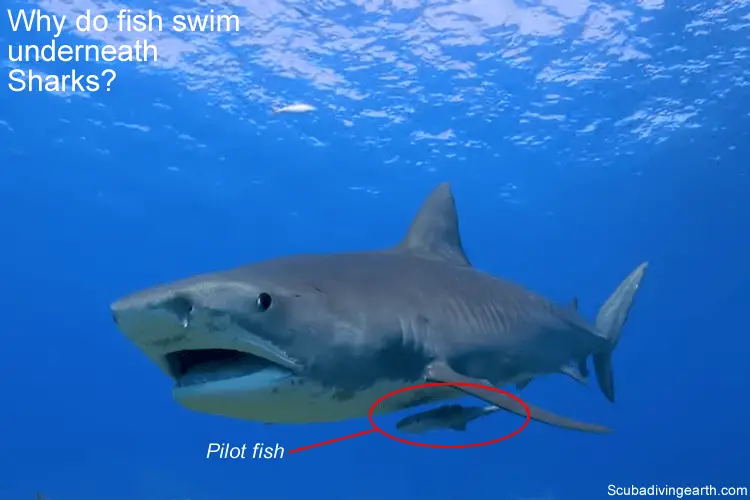
Why do fish swim underneath Sharks?
The fish that swim underneath sharks are called pilot fish. They swim there for protection, as other fish that might predate on pilot fish won’t go near sharks.
Pilot fish eat the shark parasites, which means sharks don’t eat them. Pilot fish will also pickup scraps from the meals that sharks eat.
This relationship between sharks and pilot fish is called a “mutualist” relationship.
Can great whites survive in captivity?
It turns out that due to a number of reasons great white sharks don’t survive in captivity.
The longest a Great White was held in captivity was for 44 days, which was in the Monterey Bay Aquarium back in September 2004.
Do great white sharks have predators?
The only known predator of adult great white sharks is the killer whale. Although, when great whites are in their infancy they are likely to have other predators.
Where can you go diving with sharks?
There are a number of places where you can go diving with sharks around the world. It depends on what type of sharks you’re after, as there are many places where certain types of shark are more common.
For example, if you’re looking to dive with tiger sharks, then tiger beach Bahamas is the number one place. Swimming with whale sharks can be done off Australia’s Ningaloo reef. Or perhaps you’d like to experience 700 grey reef sharks at Fakarava.
Can you swim or dive with sharks in Australia?
Australia is one of the best places in the world to go scuba diving. With The Great Barrier Reef off the East coast near Cairns and the Ningaloo Reef off the west costs of northern Western Australia.
There are over 134 species of shark found on the Great Barrier Reef to find and enjoy.
Do you get great white sharks in Australia?
If it’s great white sharks you’re looking for in Australia, they have these too. In the southern oceans off the south coast of Australia from Melbourne across to Perth in the west, you’ll find great white sharks.
Where can you dive with great white sharks in Australia?
The great white shark diving boats are located in Port Lincoln, South Australia. There are two options, either the one day shark diving trip or to spend more time on the only liveaboard boat to dive with great white sharks in South Australia.
The liveaboard boat trips go to the Neptune Islands to dive with Great White Sharks.
Can you swim with sharks in Florida?
Florida is where you can scuba dive or swim with sharks.
Located in the Caribbean sea to the south and west of Florida and the Atlantic Ocean to the east, there are many opportunities to do some great diving from Florida.
Where can you dive with great white sharks?
As already mentioned, you can dive with great white sharks from southern Australia, but there are other places to dive with these magnificent creatures too. The places where you find great white sharks include the following.
The top four places in the world to dive with great whites
- Neptune Islands, South Australia. which hosts seals and sea lions, which of course is what great whites feast upon.
- South Africa, Gansbaai diving in ‘Shark Alley’ near Dyer Island where there’s a huge fur seal colony – white shark food.
- Isla Guadelupe, Mexico where seals live on the islands.
- Stewart Island, New Zealand, also inhabited by fur seals.
Do sharks attack shark cages?
To say great white sharks don’t attack shark cages isn’t strickly true, see video below. So do sharks attack shark cages, yes they can and have, but is it likely, probably not.
But also and in general, the South Australian government claim that there is “no scientific evidence” to suggest that people are at risk from shark attack as a result of shark cage tourism.
The video below is The Discovery Channel cage dive at Stewart Island New Zealand.
An 18-foot great white attacks a shark cage while a diver is trapped inside.
I hope you enjoyed this article about scuba diving with sharks
I’d love to hear from you. Tell us about your adventures of diving and snorkeling, in the comments below. Please also share your photos. Either from your underwater cameras or videos from your waterproof Gopro’s!
If this article hasn’t answered all of your questions. If you have more questions either about snorkeling or types of scuba diving (or specifically about scuba diving with sharks), please comment below with your questions.


